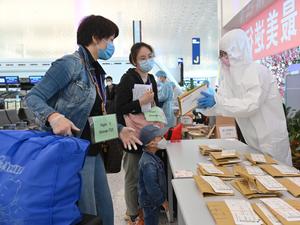 An airline employee on Thursday hands out boarding passes to Hong Kong residents stranded in Hubei province at Wuhan Tianhe International Airport, who then took a Hong Kong-bound flight chartered by the SAR government. (PHOTO / INFORMATION SERVICES DEPARTMENT)
An airline employee on Thursday hands out boarding passes to Hong Kong residents stranded in Hubei province at Wuhan Tianhe International Airport, who then took a Hong Kong-bound flight chartered by the SAR government. (PHOTO / INFORMATION SERVICES DEPARTMENT)
The government on Thursday wrapped up its second round of evacuations of Hong Kong residents stranded in Hubei province — after two chartered flights with 277 residents touched down in the city.
The two-day evacuation operations brought home a total of 558 Hong Kong residents who had been trapped in Hubei for more than two months.
The immigration department and customs in Wuhan Tianhe International Airport had provided exclusive services to the evacuation team, as the whole airport had remained closed
Patrick Nip Tak-kuen, secretary for constitutional and mainland affairs
The flights returned people from the cities of Xianning, Xiaogan, and Huangshi, which are two to three hours’ drive from the provincial capital of Wuhan.
Another 78 residents in other Hubei cities were also included because of urgent needs. This included people with severe illnesses, pregnant women, and two candidates for the Diploma of Secondary Education Examinations scheduled for April 20.
On the chartered flights, there were 23 people aged over 60, and 140 children under 16. Five relatives of five children were on the chartered aircraft to Wuhan to accompany them back to Hong Kong.
They underwent body temperature checks and health declarations after arriving in the city. These people then left the airport on their own and began a 14-day home quarantine.
After disembarking from the plane, one resident put a note on the window of a bus, thanking the Hong Kong Federation of Trade Unions for helping SAR people in Hubei over the past two months.
“We are back home,” it read.
Compared with the first batch of returnees from Hubei during the first round of the two-day evacuation operation in early March, this group seemed much more relaxed. They were exempted from the tiresome process of boarding buses provided by the government that went to quarantine camps from the airport.
The latest passengers from Hubei are not required to wear electronic tracking wristbands, while all passengers arriving from overseas now have to put on the devices and be strictly monitored.
Instead, the whereabouts of this group will be tracked by mobile apps on their phones to ensure they stay at home. The government explained that this was because the outbreak in Hubei has subsided and the risk of infection is relatively low.
Secretary for Constitutional and Mainland Affairs Patrick Nip Tak-kuen noted that most of the newly confirmed cases in Hong Kong in the past week were imported from overseas — mainly the United States, the United Kingdom and other European countries.
As of Wednesday, there had been no new confirmed cases for 21 consecutive days in Hubei except for Wuhan, which had one confirmed case on Monday.
As of Thursday, none of the 73,000 people who received quarantine orders had been diagnozed with the virus, said Nip.
The 12 SAR patients who were cured in Hubei did not return to Hong Kong along with this evacuation, said Nip. Fourteen Hong Kong residents in Hubei were diagnosed with COVID-19; of those two have died and 12 were discharged from hospitals.
Nip did not disclose the following evacuation plans for the nearly 3,000 Hong Kong residents still in Hubei. Not all of them need to return to Hong Kong as soon as possible, he explained.
Nip expressed gratitude to the central government for its concern over the evacuations and to the Hubei and Wuhan governments as well as the community groups for their assistance.
Nip said the two flights on Thursday managed to take off earlier than scheduled because everything in Wuhan went smoothly. He noted that the immigration department and customs at Wuhan Tianhe International Airport had provided exclusive services to the evacuation team, as the whole airport had remained closed.
He also thanked Hong Kong’s flag carrier, Cathay Pacific, and Cathay Dragon for providing the aircraft and crew for the operation.
A total of more than 1,000 people were evacuated from Hubei to Hong Kong on eight chartered flights in two separate operations. On March 4 and 5, four chartered flights brought back 469 Hong Kong residents from Hubei, most of whom had been stranded in Wuhan.


